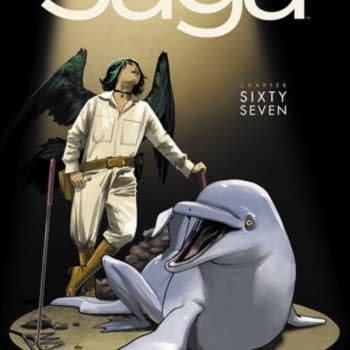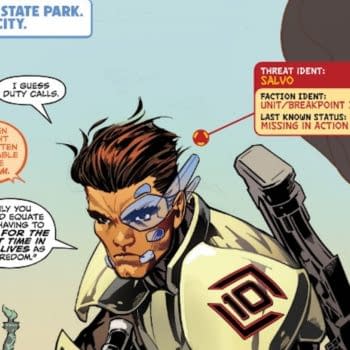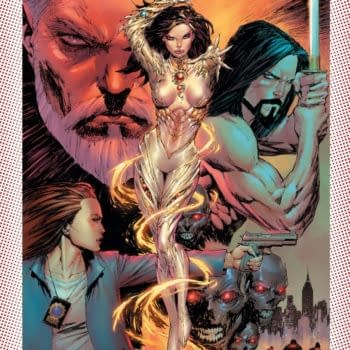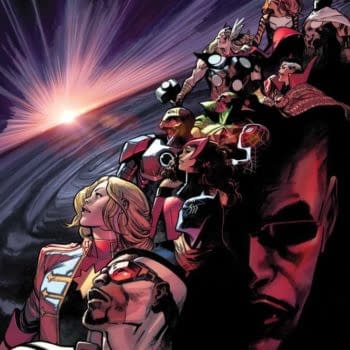Posted in: Comics, Recent Updates | Tagged: Advid Aja, Chris Eliopoulos, comic scripting, Comics, entertainment, Hawkeye #6, Josh Hechinger, Marvel Comics, matt fraction, Matt Hollingsworth
From Strip To Script – Hawkeye #6
By Josh Hechinger
Welcome once more to From Strip to Script, where I reverse-engineer a script from a finished page of someone else's comic.
By the time all y'all read this, I'll have moved to my new jawn in Philly; well, Roxborough, which ain't Philly proper, but is conveniently located up a giant hill, so I'll get to drive up and down that just in time for these hideous death winters we've been getting on the east coast in these United States.
(For all that though, I'm pretty pumped on it.)
The reason I'm getting into all that is because with moving on my mind, I've chosen a thematically-appropriate page for this installment, with the added benefit of highlighting a different scripting style than full-script: plot-first/Marvel-style.
I know I told you to Google those terms way back in our first session, but briefly: "full-script" means the writer delineates each panel's actions and dialogue in advance. "Plot-first" means that the artist provides a summary of the issue's plot, either broadly or on a page-by-page basis, and then fills in the dialogue based on how the artist has depicted that loose outline.
Some writers (and this is how I originally started scripting, believe it or not) do a kind of mix between full and plot, where they leave out panel numbers, but pre-load the dialogue.
Let's look at page from Hawkeye, from the world-beating team of David Aja (art), Chris Eliopoulos (lettering), Matt Fraction (script), and Matt Hollingsworth (color). It's a page from issue 6, which I swear I didn't pick on purpose for this, our sixth installment. It's also set in December, which also wasn't a conscious choice.
Anyway, here we go:

PAGE Seven
Monday, Dec. 17. Clint, in a grey pullover now and rocking a seriously battered and bandaged face (even by Barton standards) putters around his apartment in a Santa hat, haphazardly unpacking while Lucky lounges around. He manages to unpack some laserdiscs (yeah…) before being interrupted by a knock on the door.
(That paragraph? That's it, that's all, in pure plot-first mode. And from that, sure, you could get a 13 panel page (14, if we count the date stamp in the corner). Or you could get a three, maybe four panel page. It either gives the artist maximum freedom, or puts the maximum storytelling responsibility on them…or some mix of both.)
(Let's try it parsed out a little further)
PAGE Seven
Monday, Dec. 17.
Clint, in a grey pullover now, and rocking a seriously battered and bandaged face (even by Barton standards), putters around his apartment in a Santa hat, looking over all the boxes he's not unpacked yet. Lucky isn't helping.
– CLINT Okay, Clint. You can do this.
– CLINT You can actually move in to your apartment like a grown-ass man.
Clint flips out a butterfly knife, and just starts opening boxes.
He's delighted to find laserdiscs in one of them.
– CLINT Hey, my laserdiscs!
He admires one of them. Maybe Blade Runner, or maybe an old Western; just so long as it'd make it to laserdisc back in the day.
– CLINT I love that movie—
There's a knock at the door.
– SFX NOK NOK
Clint goes to answer it; Lucky's head has perked up, but that's about it.
– CLINT [quotes something from the flick to Lucky, or himself]
So, What'd We Learn?
– "Pure" plot-first is…not my jam. At best, it feels like a rough draft; like, I'm not an outline guy, but I'll occasionally do blurbs-per-page in a script if I know the beats I want to hit in the rest of a scene, but I've hit a wall on actually scripting them out panel-by-panel.
At worst, it just feels like going "eh, you figure it out" to the artist. Don't get me wrong, a fair bit of writing comics is knowing when to get out of the artist's way, but just laying pages out as just paragraphs feels like I'm not putting in any kinda work or craft, just…writing a pitch, almost?
– Partial plot-first, however, I'm way more comfortable with. Like I said, that's actually how I started scripting; a lot of that was a mix of not-knowing-what-I-was-doing (like I do now?) and confidence that if I lay out the right beats on the page, it doesn't matter so much how they get broken up. Or, well, it matters, obviously, but it's not something I have to dictate.
(Nowadays, I flip between full-script and partial plot, depending who I'm working with.)
– Another benefit to partial plot-first is that it gives you the space to lay out some dialogue, which in turn informs the acting and pacing in the art, which can then help you add, adjust, or remove dialogue at the end of it.
– This page is 14-odd panels because David Aja is David Aja (and real quick: that four-square of the butterfly knife? That feels like Aja having fun; the dude seems to genuinely delight in…not realism, per se, but the verisimilitude and logical progression of physical motion in his illustrations); in pure plot-first, the artist can make any number of pages out of a single paragraph.
In partial plot-first, I'd semi-subconsciously suggest at least a six panel page by way of "here's a beat, here's some lines, here's a beat, here's some lines, etc." It still relies on the artist to parse out the panels as they'd like, but it's a little more guided.
– "Clint flips out a butterfly knife, and just starts opening boxes." That's at least two panels on one line. Don't do that to an artist in full-script, yeah? I'm not super happy with myself for dropping it in partial plot-first, even.
("Clint opens a box with a butterfly knife" would be one panel, though. Comics scripting in a nutshell, gang.)
Philly-based comic writer Josh Hechinger is a Cancer, and his blood type is A+. He enjoys coffee, dogs, and his stuff not being all up in boxes. All these columns will be lost like tears in the rain, Lucky…















